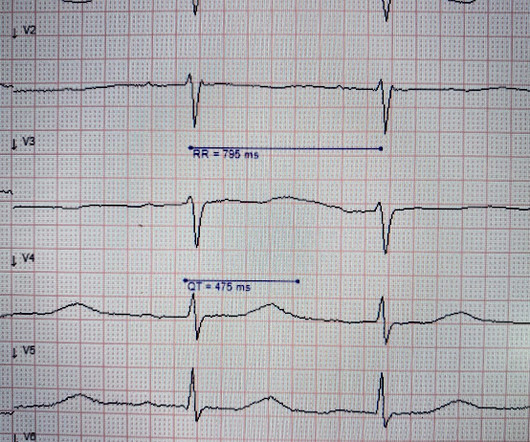EM@3AM: Brainstem Strokes
EMDocs
MAY 11, 2024
Answer : Brainstem stroke specifically in the pons resulting in locked in syndrome. CT head without contrast 1 is performed and reveals the following: Question: What is the diagnosis?

EMDocs
MAY 11, 2024
Answer : Brainstem stroke specifically in the pons resulting in locked in syndrome. CT head without contrast 1 is performed and reveals the following: Question: What is the diagnosis?

EMDocs
JUNE 3, 2023
Answer : Cerebellar Stroke Epidemiology: 1-4% of cerebrovascular accidents occur in the cerebellum. 2 In the United States, approximately 795,000 people suffer from strokes every year. 3 Cerebellar strokes are associated with high morbidity and mortality. CT head without contrast 1 reveals the following: What is the diagnosis?
This site is protected by reCAPTCHA and the Google Privacy Policy and Terms of Service apply.

Dr. Smith's ECG Blog
NOVEMBER 14, 2023
In the last post, we saw how important old ECGs are in assessing the current ECG in a patient without atypical presentation (in this previous case, the patient had no chest pain, and the apparent inferior OMI did not have reciprocal ST depression in lead aVL). Here is that last post: A 90-something with acute stroke.

Dr. Smith's ECG Blog
NOVEMBER 11, 2023
A 90-something year old woman presented with an acute mild stroke. She had a routine ECG as part of her workup: What do you think? Peak trop 62 ng/L (would be very low for acute OMI) Next AM ECG: Still with very ischemic looking T-waves. Always look at old ECGs, even if you think the diagnosis is obvious.

Dr. Smith's ECG Blog
DECEMBER 24, 2023
Here is her triage ECG: What do you think? And so was an appropriate anti-coagulant, since atrial flutter, like fibrillation, can result in thromboembolism and stroke. For clarity and ease of comparison, I've put together in Figure-1 — the 3 serial ECGs in today's case. Atrial flutter with 2:1 conduction.

Dr. Smith's ECG Blog
DECEMBER 5, 2023
Written by Kirsten Morrissey, MD with edits by Bracey, Grauer, Meyers, and Smith An older teen was transferred from an outside hospital with elevated serum troponin and and ECG demonstrating ST elevations. Acute coronary syndrome in a pediatric patient? He denied drug or alcohol use. He did have a family history notable for early CAD.

Dr. Smith's ECG Blog
SEPTEMBER 2, 2024
The ECG below was recorded by EMS. ECG #1 Interpretation: ECG #1 shows sinus rhythm at a heart rate of 77 bpm. At first glance, the ECG does not look too abnormal. In my experience, the pathologic finding in the above ECG is the easiest one to overlook — especially if you are in a rush and do not do a systematic review.
Let's personalize your content